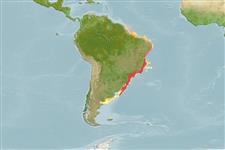>
Eupercaria/misc (Various families in series Eupercaria) >
Latilidae (Deepwater tilefishes)
Etymology: Lopholatilus: Greek, lophos = crest + Latin, latus = wide (Ref. 45335).
Eponymy: Frederico Otávio de Lemos Villar (1875–1964) was a Brazilian naval officer involved in scientific studies on the Brazilian coast, especially in relation to fisheries. (Ref. 128868), visit book page.
Environment: milieu / climate zone / depth range / distribution range
Ekologi
marina bottenlevande. Subtropical; 21°S - 40°S, 62°W - 40°W
Southwest Atlantic: Brazil, Uruguay, Argentina.
Length at first maturity / Size / Vikt / Age
Maturity: Lm 34.0 range ? - ? cm
Max length : 107 cm TL hane/ej könsbestämd; (Ref. 54989)
Collected from a depth of 142 m (Ref. 9924).
Life cycle and mating behavior
Könsmognad | Reproduktion | Lek | Ägg | Fecundity | Larver
Miranda-Ribeiro, A., 1915. Fauna Brasiliense. Pièxes Arg. Mus. Nat. Rio de J. 17, var. pag. (Ref. 9924)
IUCN Red List Status (Ref. 130435: Version 2024-2)
Threat to humans
Harmless
Human uses
Sportfisk: ja
Verktyg
Special reports
Download XML
Internet-källor
Estimates based on models
Preferred temperature (Ref.
123201): 7.9 - 23.4, mean 14.7 °C (based on 94 cells).
Phylogenetic diversity index (Ref.
82804): PD
50 = 0.7500 [Uniqueness, from 0.5 = low to 2.0 = high].
Bayesian length-weight: a=0.00708 (0.00573 - 0.00875), b=3.14 (3.08 - 3.20), in cm total length, based on LWR estimates for this species (Ref.
93245).
Trofisk nivå (Ref.
69278): 3.8 ±0.2 se; based on size and trophs of closest relatives
Resiliens (Ref.
120179): Låg, lägsta populationsfördubblingstid 4,5-14 år (tm=5-8).
Fishing Vulnerability (Ref.
59153): High to very high vulnerability (67 of 100).
